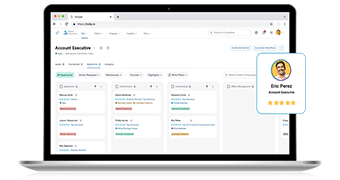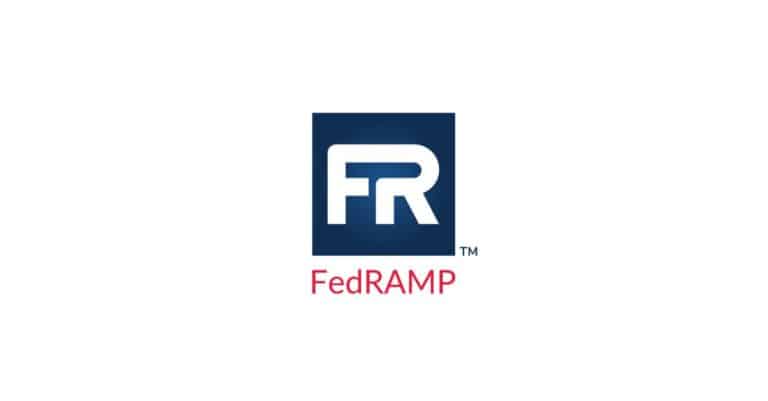Talent intelligence
and AI terms, explained
Talent intelligence
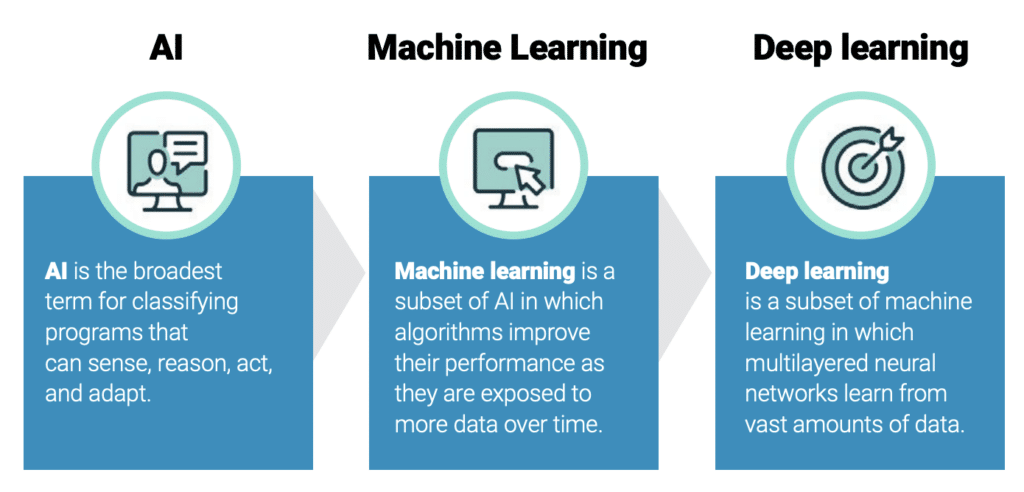
Responsible AI is the development and deployment of artificial intelligence systems in a way that is ethical, transparent, fair, and accountable. It ensures AI technologies are designed and implemented with consideration for their impact on individuals and society at large.
Talent intelligence is a new method that organizations use to collect and analyze data on internal and external talent, often with the help of AI. With talent intelligence, HR leaders can assess potential candidates, see skills in their organization and industry, and forecast future skill needs so they can align talent strategies to overall business success.
Workforce planning is the process of aligning talent strategies to support the business. It’s imperative that talent leaders focus on supply and demand, skills gaps, fulfillment, measurement, and action to determine whether they need to buy, borrow, or build talent with the skills they need.
How to build an agile and flexible workforce with talent-centered design →
Talent management
AI-powered talent management systems guide employer decisions and employee development. HR and business leaders often lose sight of their skills and capabilities after onboarding, so these systems ensure that leaders keep focused on developing employees’ potential.
Augmented talent management systems surface insights about employees’ skills and potential to help guide their careers. Talent management professionals often use these augmented technologies, powered by AI, to manage workforce development.
Employee engagement is an HR term for how invested workers are in their organizations. HR leaders often use employee engagement as a barometer for the overall health and well-being of their organization. Engaged employees take pride in their jobs and are invested in supporting their organization’s goals.
Hyper-personalization uses AI and real-time data to inform and create highly targeted products, services, content, or experiences. Talent management professionals using hyper-personalized systems powered by AI, generally receive more targeted recommendations that resonate with their audiences.
Internal mobility is the ability for employees to move to new opportunities within an organization. These moves can include transferring departments, promotions, mentorships, projects, and more.
A request for proposal, or RFP, is a public announcement asking for bids from contractors to work on a project. RFPs can include project overviews, requirements, deliverables, timelines, budgets, outcome expectations, and more.
Reskilling is the acquisition of new skills to move to another role or training for alternative roles. For example, it might be learning a new way to execute on the same job, but not necessarily learning an entirely new skill set.
Skills intelligence is the ability to understand your talent at the skills level to help you lead more effectively, better manage and motivate workers, and develop the skills needed for your organization’s future. This data is obtained by integrating technology, data analytics, and strategic insights.
Skills management is how an organization catalogs its workforce’s skills and maps them to its current and future needs. Through this process, organizational leaders should understand where to best deploy talent to support overall business goals.

Succession planning is the process of creating a talent bench to fill key positions in an organization. By identifying employees and preparing them to step up, organizational leaders are prepared when employees retire, resign, or move on.
HR systems architecture, where the talent profile is the foundational component and integrates skills, experiences, and interests to create a dynamic understanding of talent that can be used both within traditional constructs of jobs and new and evolving ways of work.
Talent experience (TX) is an employee-centric approach to managing talent. Using a talent management system that highlights employees’ skills and potential shows them learning and career growth opportunities that improve their experiences and instill purpose.
Talent management analytics and reports use employee data to inform decision-making around workforce planning and organizational goals. HR professionals use talent management analytics and reports to improve HR functions and performance.
A talent marketplace is an AI-powered digital platform that aligns employees’ skills to new roles, projects, mentorships, and other opportunities within the organization. HR and talent management leaders use this talent marketplace to improve internal mobility and retention.
Talent misalignment is the disconnect between workforce capabilities, skills, or resources and strategic business goals. This misalignment creates skills gaps, mismatches workers to roles, or underutilizes talent, leading to a reduction in productivity.
Talent redeployment is moving or reassigning employees into new roles or departments to make better use of their skills.
Talent retention, or employee retention, is the process of keeping top talent from leaving your organization. HR and business leaders need a strategy in place so they can easily see and engage high performers, as turnover can be expensive and disruptive to a workforce and delay business outcomes.
Upskilling is the practice of teaching workers new skills or capabilities to build upon their existing roles. Upskilling should be based on employees’ potential to learn more advanced skills that will add to their skills portfolio — and better support the organization’s goals.
Talent acquisition
AI recruiting is any technology that uses artificial intelligence to support one or more aspects of the recruiting process. It leverages machine learning algorithms to automate and optimize various recruitment tasks.
AI-powered sourcing uses artificial intelligence to help source and select candidates. This is incredibly powerful in the talent acquisition process for recruiters, as they can surface best-fit candidates targeting their skills and capabilities from a larger talent pool.
Campus recruiting refers to when an organization’s recruiters visit a university, college, technical, or other educational institution to meet potential new applicants. Companies often work with university career centers to find new candidates through this method of sourcing.
Candidates experience (CX) is the entire end-to-end recruiting experience for the applicant. Providing a streamlined and personalized candidate experience ensures that applicants have a positive introduction to your organization and are more likely to accept an offer.
Candidate prioritization is the HR process of aligning candidates to roles based on their relevant skills and experience. To facilitate the process, recruiting teams can use AI-powered skills insights to help them determine best-fit candidates for the interview process.
Candidate relationship management, or CRM, is the process of sourcing, selecting, and nurturing talent through the entire candidate life cycle. This includes finding and engaging candidates for open roles and cultivating a connection with them to guide them through the full recruiting process.
A chatbot refers to an automated response system, also known as conversational AI, built to answer basic customer questions in a friendly style. Many companies use chatbots to capture initial customer inquiries and then route them to the best responses or a human agent, helping them resolve issues more quickly.
Contingent workforce management is the process of hiring and managing contract workers for specific projects. This includes contractors, gig workers, freelancers, agency staff, and temporary staff. Contingent workers are often sourced through staffing agencies on a per-project basis.
Conversational AI recruitment uses artificial intelligence to facilitate conversations with potential candidates with natural language processing (NLP). With automated questions starting the conversation, recruiters can begin to qualify candidates for open positions.
Event recruiting refers to a career fair or other in-person event where candidates can meet with potential employers. These often provide more informal opportunities for applicants to learn more about an organization and how they might be a good fit.
Interview scheduling and feedback refers to the steps of moving a candidate through the screening process. Today, the scheduling, screening, and feedback process often involves the recruiter, the hiring manager, potential teammates, and leaders. Every interviewer then inputs their feedback to decide on the best-fit candidate for the position collectively.
Reference checks are essentially background checks with former employers, clients, colleagues, and others for candidates in the talent acquisition process. These typically occur at the end of the recruiting process before making an offer.
Referral management is the system an organization uses to document candidate referrals in the recruitment process. These are often current or former employee referrals of potential best-fit candidates for the organization.
Talent acquisition management is the strategic process of attracting, hiring, and retaining the talent an organization needs to thrive. This process includes identifying staffing needs, developing sourcing strategies, managing hiring and onboarding, and supporting training and performance evaluations to ensure employees succeed in their roles.
Doing more with less: Creating an agile and adaptive talent acquisition strategy →
Talent sourcing is the process of generating a consistent flow of high-quality candidates to join your talent pool. This includes sourcing, researching, networking, and other efforts to create and maintain a robust talent pipeline so that when you need to hire, you have quality applicants ready to access.
Talent resource management
Skills-based project matching uses data to identify and present new projects to available employees. By using skills-based matching, resource and engagement managers can ensure they’re finding the best-fit matches to take on projects.

A talent marketplace is an AI-powered digital platform that HR and talent management teams use to match best-fit talent to opportunities based on their skills, capabilities, and interests. An AI-powered talent marketplace can more efficiently and effectively match talent to roles, projects, gigs, mentorships, and more.
Diversity and inclusion (D&I)
Workforce diversity means including and representing people from all backgrounds and experiences in terms of age, race, cultural background, physical abilities and disabilities, religion, gender, and sexual orientation. This inclusive environment should provide equal rights and opportunities for everyone.
Integrating diversity from the start: How AI is shaping this essential business practice →
Related resources
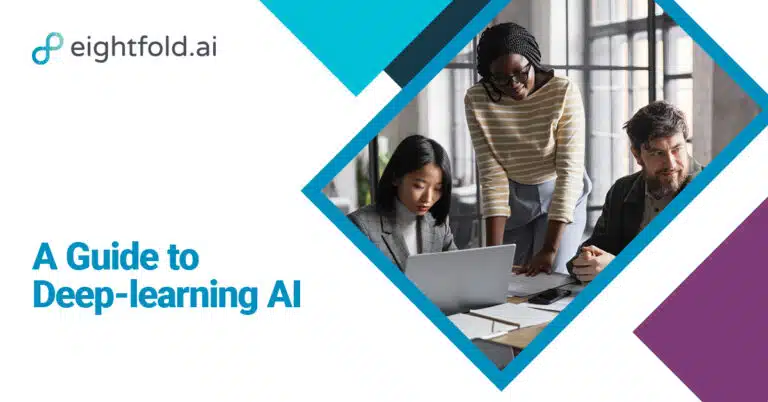
A guide to deep-learning AI
All AI-powered talent intelligence platforms are not created the same. Here is what you need to know.
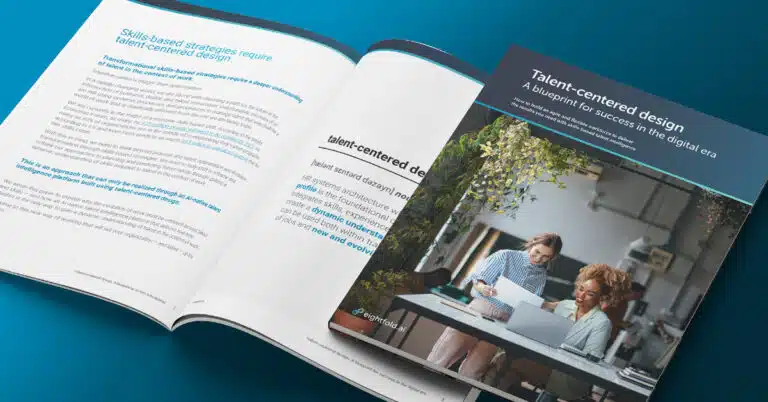
Talent-centered design: A blueprint for success
Welcome to the new world of workforce planning based on talent-centered design.

Responsible AI at Eightfold
As the pioneer and leader in talent intelligence, our mission is to enable the right career for everyone.

